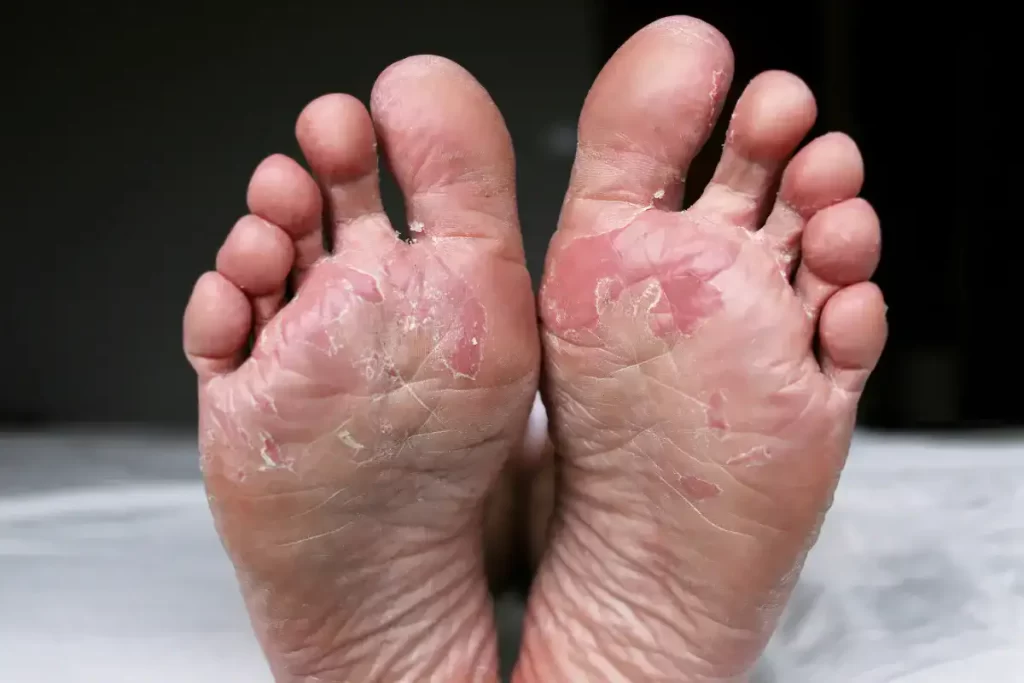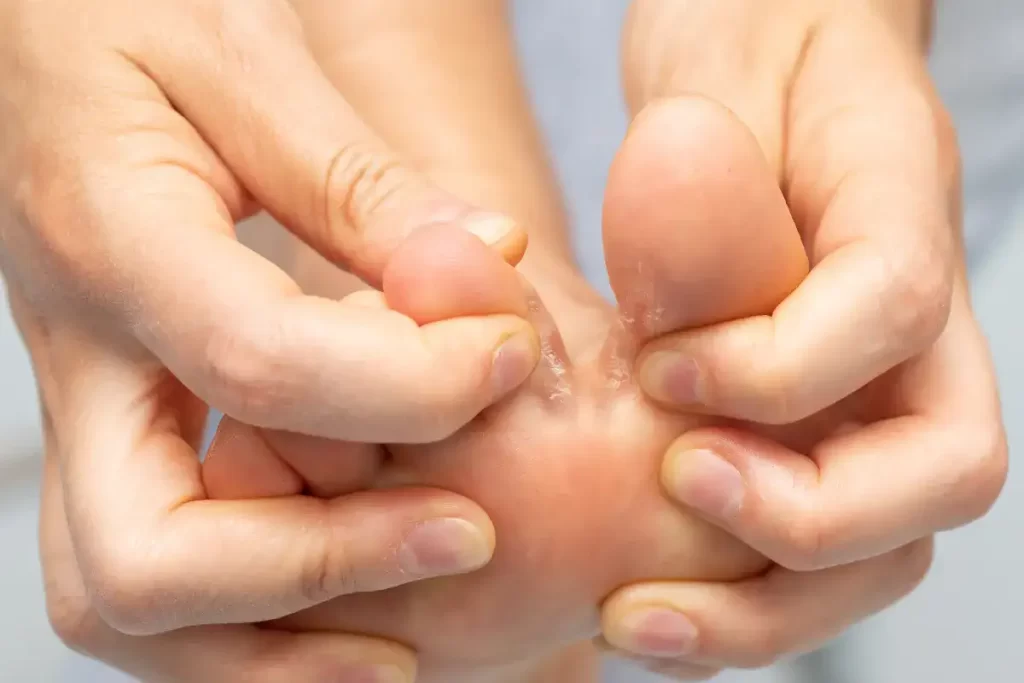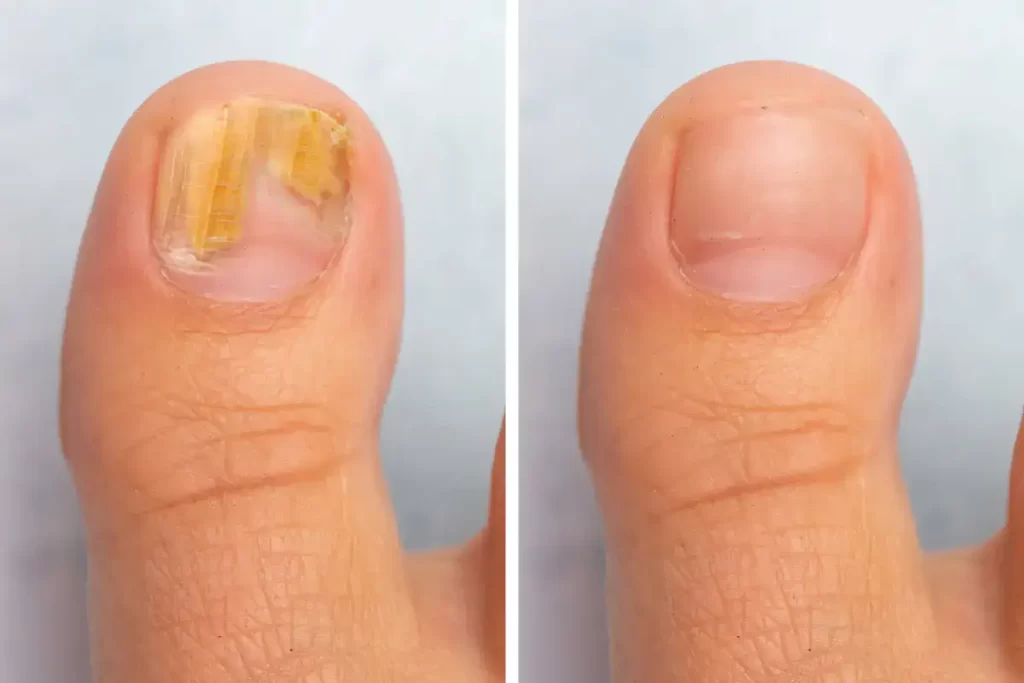Foot fungal infections, though common, often go unnoticed until they cause discomfort or become visibly apparent. Because foot fungi grow in warm, moist environments, they tend to thrive in shoes and socks and warm communal environments, like locker rooms and gyms. Though there are various types of foot fungus, tinea pedis and onychomycosis are the most common infections in adults.
Is foot fungus contagious?
This question is just as common as fungal foot infections. Yes, foot fungal infections, particularly athlete’s foot, are contagious. Direct contact with the infected skin or surfaces contaminated with the fungi can lead to transmission, which is one reason why it’s important to treat a fungal infection at the first signs of symptoms to not pass on the infection to someone else or even to another part of your body.
Tinea Pedis (Athlete’s Foot)
If you think you have a foot infection, your first thought might have been “athlete’s foot” – and for good reason. Athlete’s foot, or tinea pedis) is one of the most prevalent foot fungal infections because it’s highly contagious and can spread through contact with infected surfaces or through person-to-person contact.
Tinea pedis thrives in public spaces and is easily picked up around pools and locker rooms – or by sharing towels, sheets, or socks with someone with the infection. Though athlete’s foot typically presents as burning or itchy feet with an apparent rash, athlete’s foot symptoms vary by type of tinea pedis infection.
Interdigital Infection
Also called a toe web infection, interdigital athlete’s foot typically appears between the toes, most often between the fourth and fifth toes. This type of foot infection usually causes burning and itching between the toes and a scaly red rash that can even smell or discharge.
Moccasin Infection
Aptly named, a moccasin infection runs along the sole and can stretch up the sides and the heel, encasing the foot like a moccasin. This type of athlete’s foot initially presents as dryness and soreness, then progresses to itchy, cracked, and/or peeling skin. If left untreated, the infection can spread to the toenails.
Vesicular Infection
Known colloquially as blisters, vesicular infections present as small red blisters between the toes and on the sole of the foot. This rash is typically painful and itchy and people with a vesicular infection are at risk of an additional bacterial infection if the blisters pop.
Ulcerative Infection
Though uncommon, a foot infection can cause open sores, or ulcers, that are also prone to bacterial infection. This type of infection is very painful, and results in inflamed, discolored skin and oozing discharge.
Athlete’s Foot Cream & Tinea Pedis Medication
Early diagnosis and treatment of a foot fungal infection can help reduce both the spread of the fungus and the recovery time. There are a number of over-the-counter medications that are effective in treating mild to moderate cases of athlete’s foot, though more severe cases may require a prescription from a podiatrist or general practitioner.
Common foot fungus treatments include:
- Foot fungus creams and lotions
- Antifungal ointments, powders, and sprays
- Foot soak for toenail fungus (antifungal foot soaks and diluted vinegar soaks)
- Prescription-strength ointment (clotrimazole, econazole, or ciclopirox)
- Antifungal pills (terbinafine or itraconazole)
Onychomycosis (Toenail Fungus)
Another common type of foot fungus, onychomycosis, affects the nails (vs the sole). This type of foot infection typically starts at the edges of the toenail or the nail beds and may lead to discoloration, thickening, and crumbling of the infected nail(s) if left untreated. While there are three main types of onychomycosis, infection occurs when fungi enter the nail via a small crack in the nail or surrounding tissue.
Subnugual Onychomycosis
This type of toenail fungus is caused by dermatophytes (the same type of fungus that causes athlete’s foot). There are 40 different species of dermatophytes that can cause this type of foot infection.
White Superficial Onychomycosis
While white superficial onychomycosis is the easiest toenail infection to treat, it also can spread across the nail extremely quickly, so catching it early is key. This toenail fungus first appears as white spots on the top layer of the toenail and can be caused by approximately 1,100 different species of hyphomycetes.
Candida Onychomycosis
Though this type of fungal infection more commonly affects the GI track, candida onychomycosis is another type of fungal toenail infection. Unlike the previous two infections, candida onychomycosis is caused by candida, a type of yeast.
Onychomycosis Treatment
Toenail infections will not go away on their own and cannot be treated with home remedies. Like athlete’s foot, early onychomycosis can be treated with over-the-counter (OTC) antifungal medications. Unfortunately, fungal nail infections can be difficult to cure and often reoccur – especially for people with diabetes. If OTC creams fail to clear the infection, your podiatrist can prescribe a medication that should clear the infection. In rare, severe cases or instances of repeat reinfections, your doctor may recommend surgical intervention.
If you are suffering from a fungal foot infection, don’t wait to see your podiatrist for diagnosis and treatment. The sooner you seek treatment, the faster your infection will clear.



2 Comments
Why/what makes the foot ture white,dry? Its taken months to finally get them to look like j e feet again after useing a dremal to sand them and soak in Epson salt and vinegar. But it still keeps coming back? Please help
hello my toes looks exactly this how to fix please. My doctor said it is not normal but yesterday even it started bubbling up and I am a little confused what’s happening. If u have any idea please let me know before I have to lose my foot and get it cut off. I would really miss my daily foot rubs from my grandma if I have to get it amputated… xoxoxxoooxoxxo navie